Sand-laden manure handling and storage
Learn about the use of sand as bedding and the challenges of handling sand-laden manure in livestock barns. This technical information is for Ontario dairy producers.
ISSN 1198-712X, Published January 2012
Introduction
Sand has been used as a bedding material in free-stall barns for over 30 years. It has grown in popularity because of the benefits it offers to dairy cows. Some tie-stall producers are also using sand to take advantage of these benefits. Sand, however, has some limitations as it cannot be used in slated floor barns, and it increases wear on manure-handling equipment because of its abrasive properties.
Sand bedding offers many benefits for the dairy cow:
- is comfortable (Figure 1)
- provides excellent traction
- limits bacterial growth because it is inorganic
- does not produce hock abrasions
- is relatively inexpensive
- is easy to obtain in most parts of the province
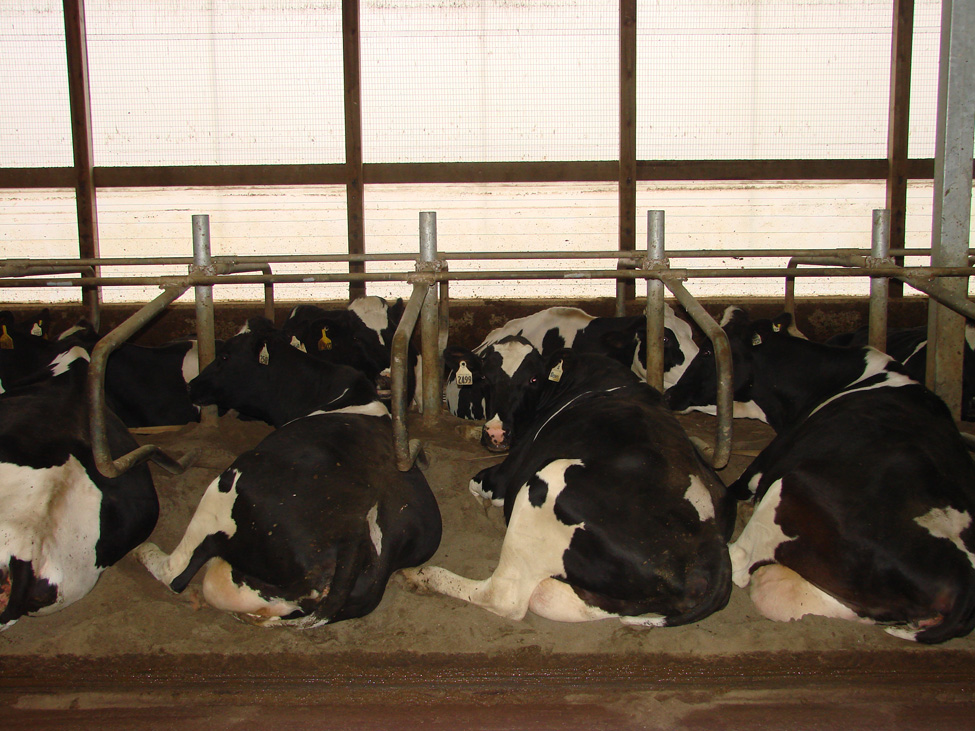
One producer, when asked why he used sand bedding, stated, “I always knew that sand was good, but I never knew how good until we actually started using it!” Although an excellent bedding material for cows, it does result in some challenges when it leaves the stall and becomes mixed with manure. This fact sheet describes the use of sand as bedding and concentrates on the challenges of handling sand-laden manure.
Management of sand in stalls
Not all sand is created equal. Sand can vary from a very fine dust to a very coarse, almost-gravel material. The finer the sand, the better it will stay in suspension with manure. The coarser the sand, the easier it is to separate from the manure. Both these properties are important when deciding how to handle sand-laden manure.
It is important that the sand is free from small stones and contain very little clay, if possible. Small stones become lodged in the cow’s hooves and cause lameness. If there is too much clay, the stalls will pack down, becoming hard and uncomfortable for the cows. If there is a source of sand on the farm, screen the sand to remove the stones or clay, if necessary.
The other source of sand is sand and gravel companies. These companies screen the sand and provide consistent quality. The sand will vary in texture from pit to pit, so it may be necessary to try a couple of sources before deciding on what best suits your needs.
Sand stalls are designed without a concrete base, but with a curb at the back to retain the sand. The curb should be about 20 cm (8 in.) high and 15 cm (6 in.) wide. It should be tapered on the inside, but not come to a point, as you want the cow standing on sand and not causing too much of a pressure point with the concrete.
Maintain the sand surface in the stalls to provide a uniform slope about 5–8 cm (2–3 in.) above level at the front of the stall, tapering to the curb height at the rear of the stall (Figure 2). Fill the stalls regularly. The more often the stall is filled to maintain the recommended slope, the less sand the cows will kick out. If too much sand is added to the stalls at one time, the cows will paw at it until they get it to a comfortable depth. It is better to fill the stalls more often, with lesser amounts of sand, than once a month with a lot. Most producers fill stalls once every week or two. If stalls are not filled often enough, cows will dig down below the curb, and the stall length will be reduced by the width of the curb.
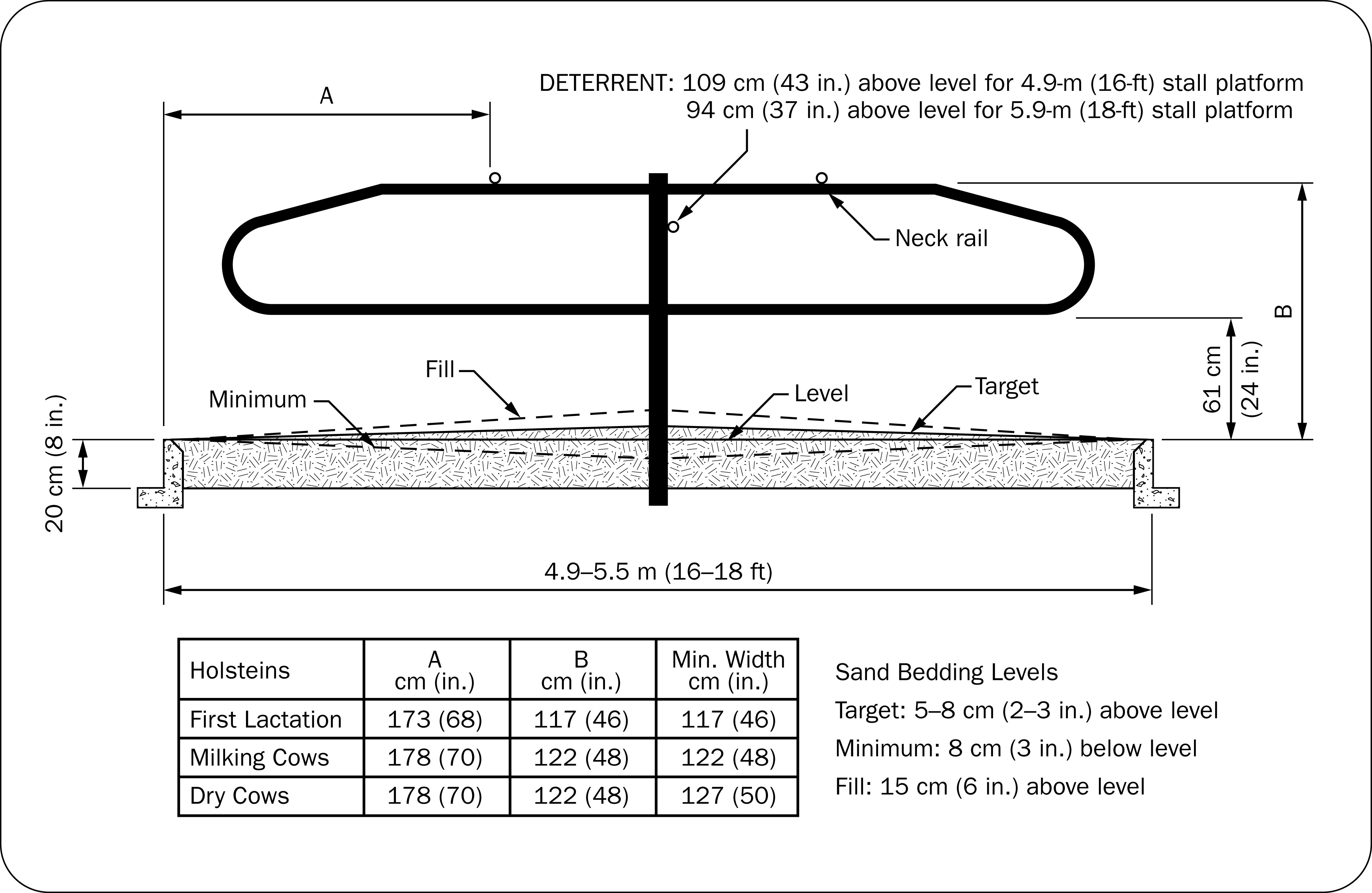
Fill stalls with sand using a skid steer or tractor and bucket or with a specialized sand slinger. Using a bucket on the front-end loader, the skid steer or tractor has to turn 90° in the scrape alley to dump into the stalls. To allow for this turning, it is important to have alleys at least 2.7 m (9 ft) wide. Sand slingers, as the name implies, are used to throw sand into the stalls. They come in two basic types, a bucket slinger and a wagon slinger. The bucket slinger is used to both pick up the sand and throw it into the stall (Figure 3). The wagon slinger is pulled behind a tractor. It has a much larger capacity, so it will fill many more stalls than the bucket method before it has to be refilled.
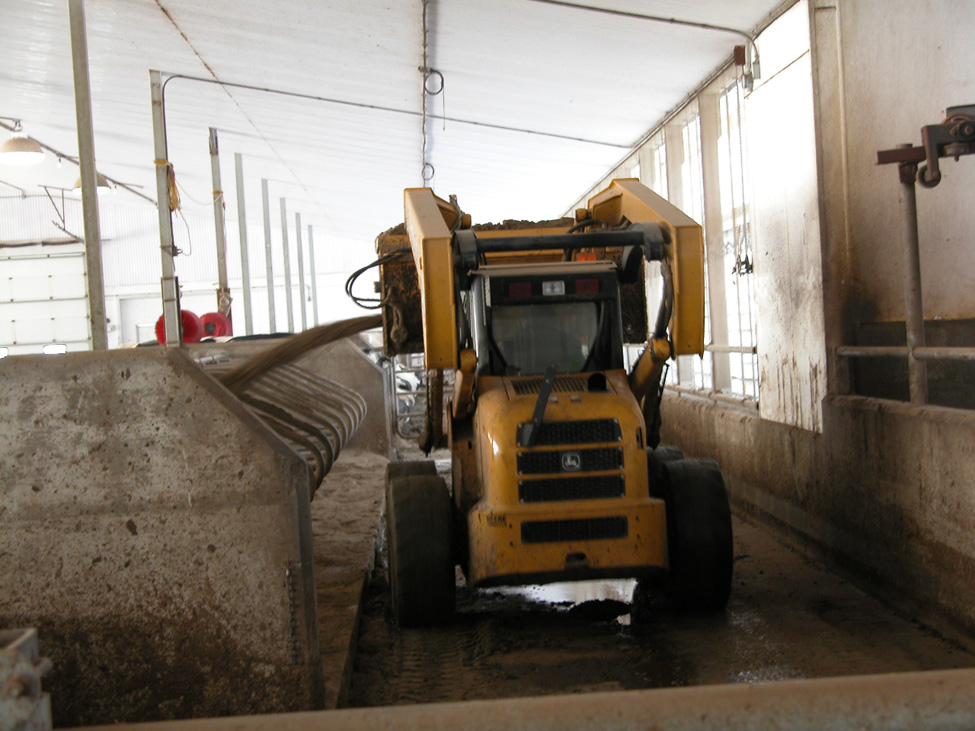
Maintain the stalls regularly. “Walk” the stalls with a rake to remove manure in the stalls and fill in any big holes. Some producers use special cultivator attachments to level the stalls and to loosen up the sand. Depending on the size of the sand particles, the sand can pack down and harden over time.
Producers use different devices to reduce their amount of sand use. One method is to bury car or truck tires in concrete and cover them with sand. Other sand saver options are available in the form of tire strips or expanded plastic strips. Reducing sand use is not always a positive thing — when the cow kicks sand out of the free-stall, the stall gets partially cleaned out. The best way to reduce sand use is to keep the stall uniformly full. A study of 57 Midwest dairy farms showed an average sand use of 24 kg (53 lbs.) per stall per day. This amount can be cut in half by more frequent filling and stall management.
One sand saving method that does work well at reducing sand use, while not compromising cow comfort, is burying a type of cow mattress 5–8 cm (2–3 in.) below the sand. This stops the cows from digging deep holes and removing more sand than is necessary for cleanliness.
Challenges of handling sand-laden manure
The challenges of working with sand-laden manure are related to the physical properties of the sand. Sand has a density of 1,750–2,100 kg/m3 (110–130 lbs./ft3) depending on its moisture content. Sand does not absorb moisture, so it adds volume to the sand-manure mix, while lowering the moisture content. In the end, the sand-laden manure is heavier, drier and grittier than manure with organic bedding. This increase in weight, volume and density makes sand-laden manure extremely hard on manure-handling equipment, especially on liquid manure pumps.
Collection
When handling sand-laden manure, the simpler the system, the better. The amount of labour and time available and the amount of automation desired determine the best approach. There are three methods used for collecting the sand-laden manure.
Scrape with tractor or skid steer
The simplest method of collecting sand-laden manure is to scrape with a tractor or skid steer (Figure 4).
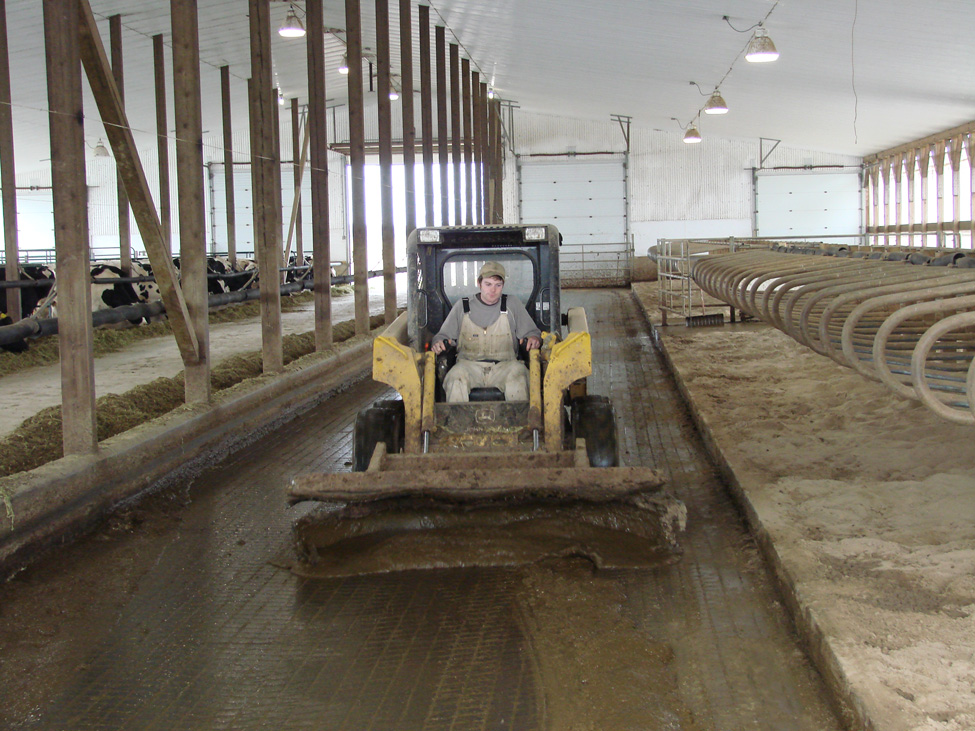
Rubber tire scrapers are used when the barn temperature is above freezing, but a metal scraper blade is necessary when the sand-laden manure starts to freeze. Scraping can only be done when the cows are being milked, two or three times per day. This can result in dirtier alleys, which may lead to dirtier cows. It is best to make the alleys wider when using this system, as the alley becomes a form of temporary manure storage.
Automatic alley scraper
Automatic alley scrapers allow for more frequent alley scraping than tractors or skid steers, resulting in cleaner alleys. Wear and tear on equipment is a major concern when handling sand-laden manure. Chain drive scrapers are not recommended because of the increased wear and tear. However, in extremely long barns with multiple scrapers, flat iron has been used to replace the chain between scraper blades, leaving only chain at the drive wheels.
Cable drive scrapers are more common. Use a galvanized cable when the scraper is first installed until the rough edges of the concrete are worn off. After that, use a better-quality stainless-steel cable. Stainless steel cables are about three times the price of galvanized cable. Some cables now have a nylon coating. It is also a good idea to form a 2.5 cm wide × 6.5 cm deep (1 in. × 2.5 in.) groove for the cable to track in. Some producers routinely replace their cable once a year, whether it looks like it needs it or not. They find that the cable tends to break shortly after a year’s use, and it is better to pick the time to change it than having it break at an inopportune time.
Flush
The other method of collecting manure is a flush system. Although not common in Ontario, flush systems are used quite effectively to collect and transfer sand-laden manure. A flush system provides an opportunity to separate the sand from the manure. Flush systems for handling sand-laden manure are designed similar to flush systems for handling manure with organic bedding but may require higher volumes and speeds to move the sand-laden manure.
Transfer to long-term storage
Once the sand-laden manure is collected from the barn alleys, it is transferred to an intermediate system within the barn or directly to long-term storage. A variety of transfer methods can be used.
The simplest method of transferring manure is to use gravity. However, some traditional gravity transfer systems do not work well with sand-laden manure. Traditional systems consist of a vertical 750–900 mm (30–36 in.), smooth-walled pipe at the barn that drops to the level of the bottom of the manure storage, or slightly deeper. A 90° elbow or two 45° elbows connect the vertical section of pipe to the pipe that runs horizontally out to the storage. Sand will settle out in this system and plug it.
There are two types of gravity flow systems that work well when transferring sand-laden manure from the barn to long-term storage. One uses a trench, and the other a pipe.
Gravity Trench
The trench transfer system consists of a rectangular trench 2.4–3 m (8–10 ft) wide and the same depth as the bottom of the long-term storage. The trench extends under the barn and out to the manure storage (Figure 5). Manure is scraped from the alley and into the trench through openings or slats in the floor. The sand-laden manure flows from the trench into the manure storage. The manure level in the storage is the same as the level in the transfer trench. The sand, however, will settle out more in the trench, and build up a slope that is highest at the end of the trench furthest from the manure storage. During clean-out of the manure storage, the transfer trench is also cleaned out. For this system to work well, the manure storage must be as close to the barn as possible, usually 9 m (30 ft) or less. Cover the opening to the trench at the manure storage with a heavy tarp to prevent wind blowing through the trench back into the barn.
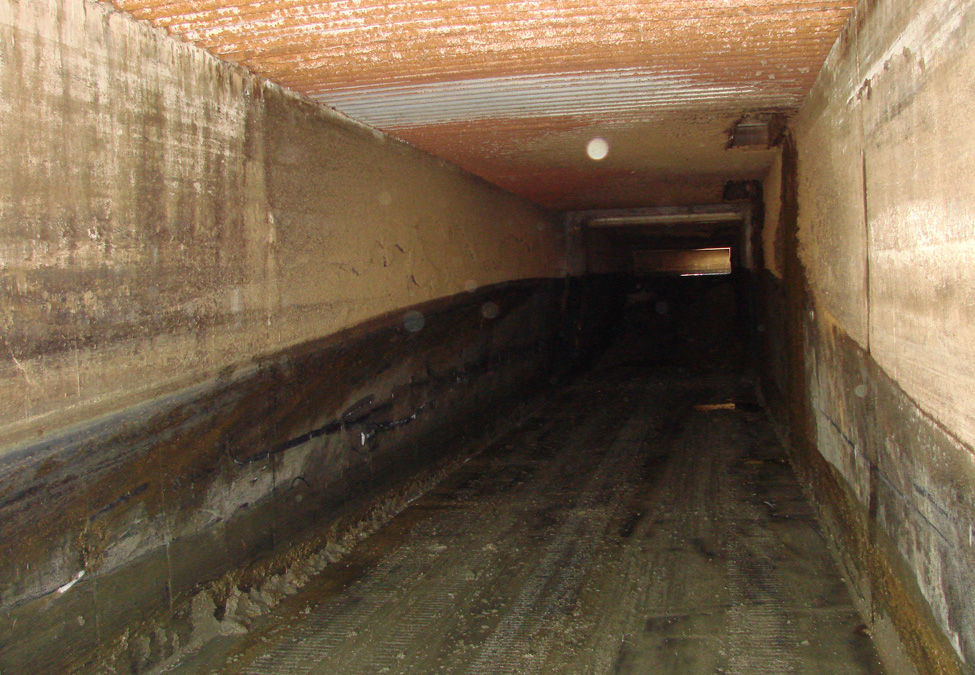
Gravity pipe
The gravity pipe system consists of a pipe installed across the width of the barn. The 750–900 mm (30–36 in.) diameter pipe is installed 600–900 mm (24–36 in.) beneath the floor on a slope of about 0.2%–0.4% towards the storage (Figure 6). Slots are cut into the top of the pipe at the end of each alley. These slots are 20–25 cm (8–10 in.) wide and formed through the concrete to the surface. The pipe extends over the top of the manure storage, and it works best to cut a hole in the bottom of the pipe to allow the manure to fall through, and to plug or cover the end of the pipe to keep cold winds from blowing back into the barn. During freezing weather, manure may form from the storage up to the pipe and block the flow. Remove this manure with a high hoe or something similar.
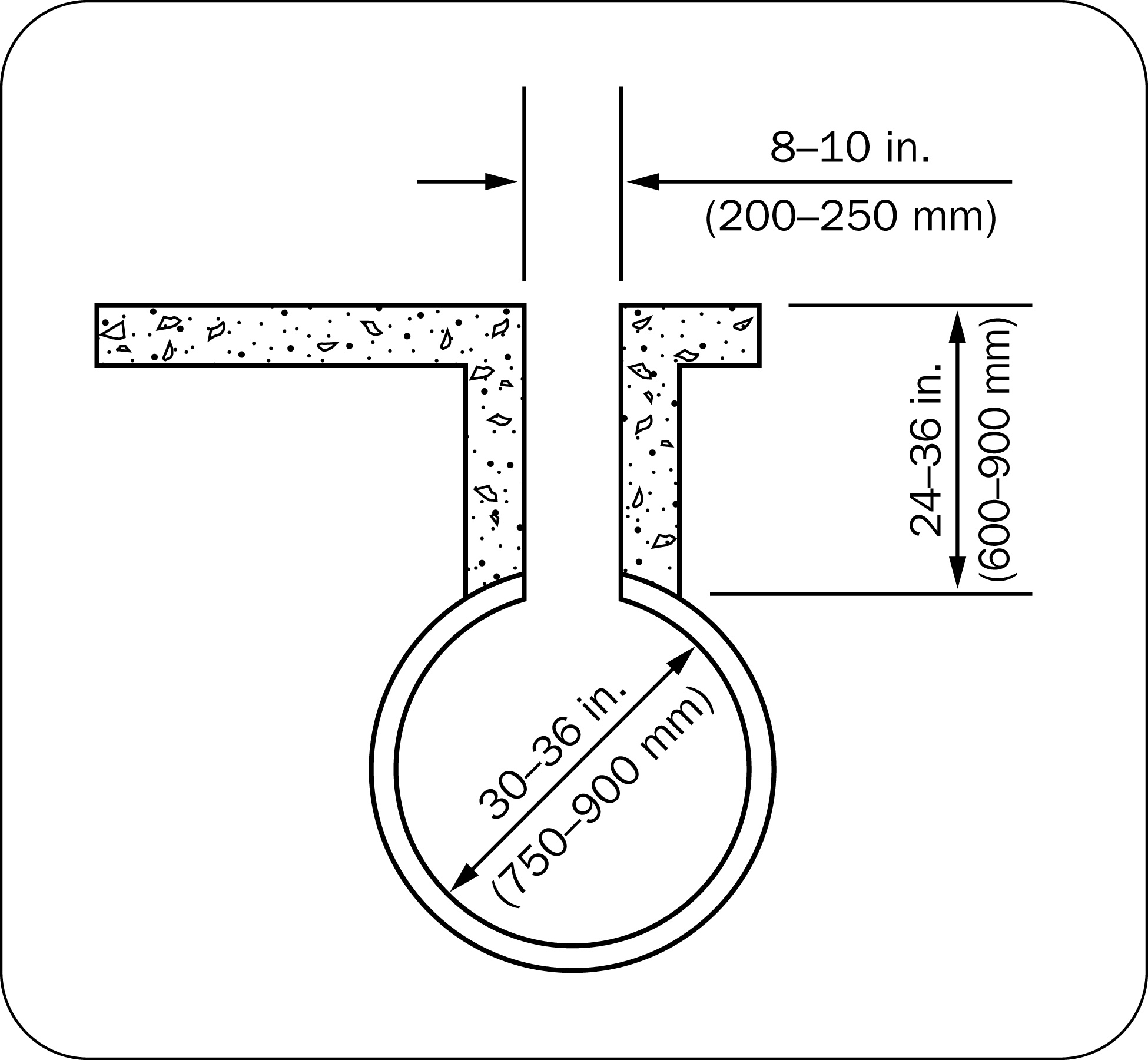
This system works best when the manure is collected with a tractor or skid steer. The flush of sand-laden manure each time the alleys are scraped seems to be enough to keep the sand-laden manure flowing through the pipe and out into the manure storage. Having the pipe buried 600–900 mm (24–36 in.) below the floor also provides some pressure to push the manure out. There is some debate about adding extra water to this gravity flush pipe. Some installations have directed parlour washwater through a separate pipe to the storage, while others have emptied the washwater in the top end of the gravity transfer pipe.
In either case, it is best to bury a 10-cm (4-in.) diameter pipe that can empty into the top end of the transfer pipe, from the long-term storage alongside the gravity transfer pipe. If the transfer pipe plugs, liquids are recycled from the long-term storage and used to clean out the transfer pipe.
Another variation on the 750–900 mm (30–36 in.) diameter gravity transfer pipe is to cut a 122-cm (48-in.) pipe in half and form it into the bottom of a 1.2 m (4 ft) wide U-shaped trench (Figure 7). The trench is then covered with slats that the sand-laden manure can be pushed through. This design is useful where cattle need easy access across the transfer trench.
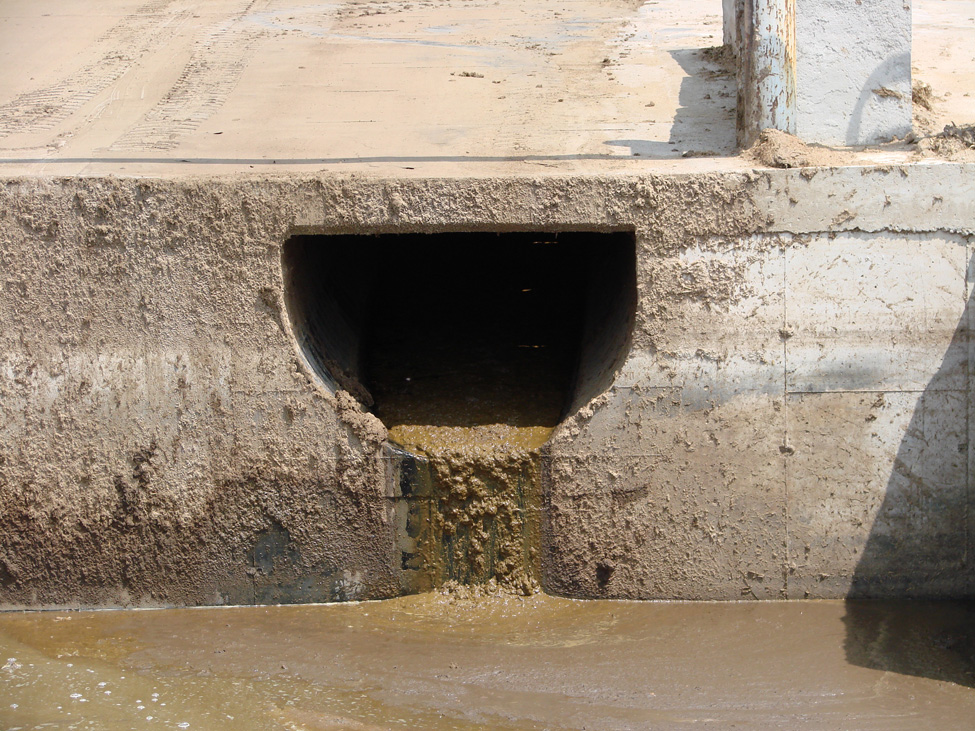
Gutter Cleaner
The most common method of mechanical transfer is to use a gutter cleaner (Figure 8), although the abrasion of the sand causes wear and tear on moving parts. When using a gutter cleaner, install extra reinforcing beneath the wear heel of the gutter cleaner chain. Heavy conveyor belting or 1 cm × 10–13 cm (0.5 in. × 4–5 in.) steel plate is sometimes used to prevent the chain from cutting into the concrete. The gutter cleaner is sometimes used to collect the sand-laden manure from the ends of the alley and transfer it to a pump, or to transfer it directly to a long-term storage. If the gutter cleaner extends beyond the barn to the long-term storage, keep the chain from freezing to the gutter. Cover and insulate the gutter trench beyond the barn. Install a heating cable in the bottom and sides of the trench to keep it from freezing. Another method is to install a small fan where the trench exits the barn and blow warm barn air out through the trench to keep it from freezing.
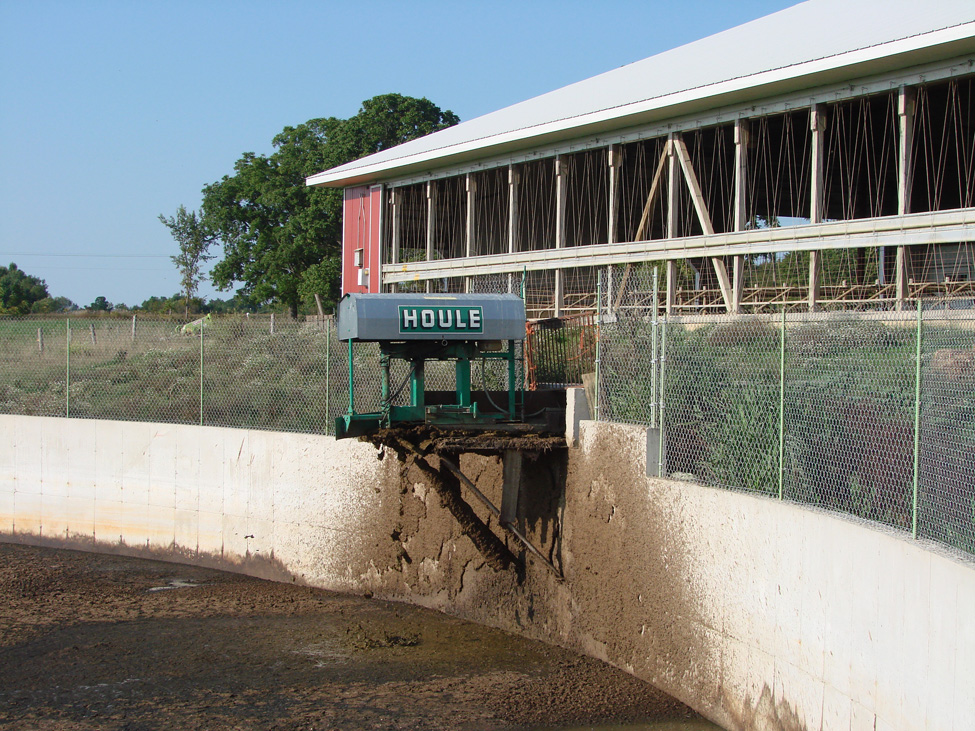
Hydraulic shuttle
Hydraulic shuttle cleaners can be used in a single gutter to transfer sand-laden manure, but the wear and tear on moving parts will increase.
Bucket conveyor
A bucket conveyor can be used effectively to collect sand-laden manure from collection lanes and transfer it to long-term storage. Buckets are usually installed in 1 m × 1 m (3 ft × 3 ft) collection lanes. Once again, provide insulation and some heat to keep the bucket from freezing.
Hydraulic pump
When the long-term manure storage is located a distance away from the barn, the most common transfer system is a hydraulic pump specifically manufactured to work with sand (Figure 9). While these pumps have special valve systems to work with sand-laden manure, sand can still settle out in the discharge pipe. Install air injectors in the discharge pipe to clean out the line and prevent plugging.
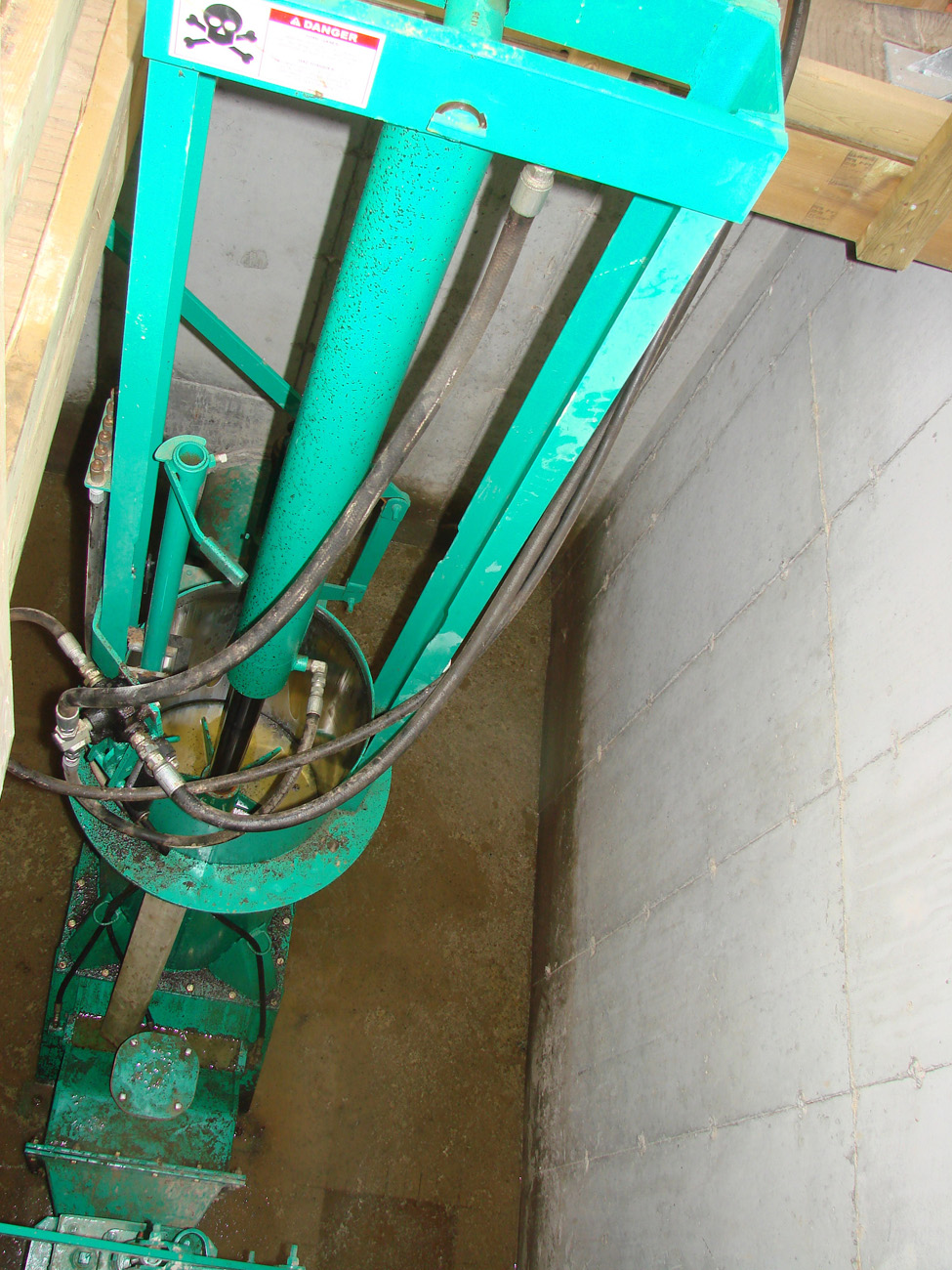
Centrifugal pump
Occasionally, centrifugal pumps are used to move sand-laden manure. It is important to have pumps with sealed bearings, designed to work with sand and to allow worn components to be easily replaced.
Separation
There are two reasons to try to separate the sand out of sand-laden manure. One is to reduce the wear and tear on the manure-handling components, and the other is to recapture the sand so that it can be re-used as bedding. There are a variety of ways that producers try to separate the sand from the manure.
Static separator with settling tank
Some producers have constructed systems that incorporate sand-settling tanks prior to the long-term manure storage. Overall, these have not performed very well. Depending on the size of the settling tank, both the manure and sand settle out and then flow over into the second tank. More sand is trapped in the first tank by using an adjustable level between the two tanks, but some will continue to flow through.
Static separator with two tanks
Settling tanks have worked more effectively if two equal-sized tanks are used to store the sand-laden manure. In this system, all the sand-laden manure is collected in the first tank, and when the level reaches a certain height, the liquid is transferred by gravity or a pump to the second storage (Figure 10). With practice, most of the sand is trapped in the first tank. Most of the organic manure is trapped here as well. By carefully selecting when the liquid is transferred or carefully choosing the depth of the pump, mostly liquid is transferred to the second tank. The liquid in the second tank can be agitated and pumped, leaving very little sediment.
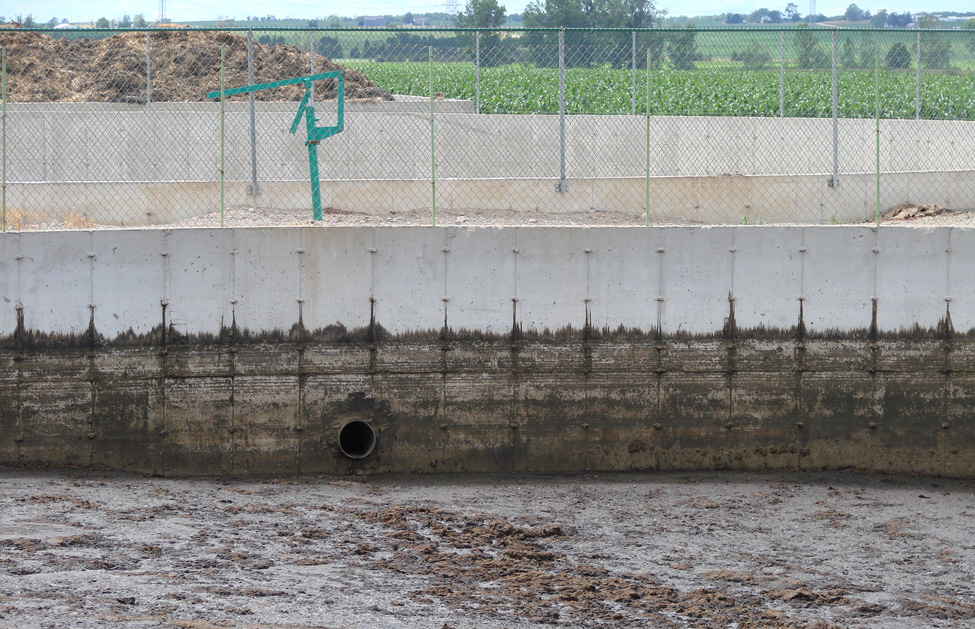
Flush/settling tanks
An alternative option to static settling tanks is a flush flume. Dilution water is pumped through a transfer pipe and flushes the sand-laden manure into a settling tank. As the sand-laden manure enters the tank, it changes velocity, and the sand settles out more rapidly than the manure (Figure 11). The liquid manure is then transferred to long-term storage or recycled through the flush flume pipe in the barn. The settling tank has an access ramp for easy entry so that a tractor and loader or skid steer loader can remove the sediment and pile it so that any further liquid drains back into the settling basin or into the long-term storage. The settled sand is not pure enough to be re-used in the stalls and must be applied to a field. However, enough sand is removed to make agitation and pumping of the long-term storage easier, resulting in less wear and tear on pumping equipment.
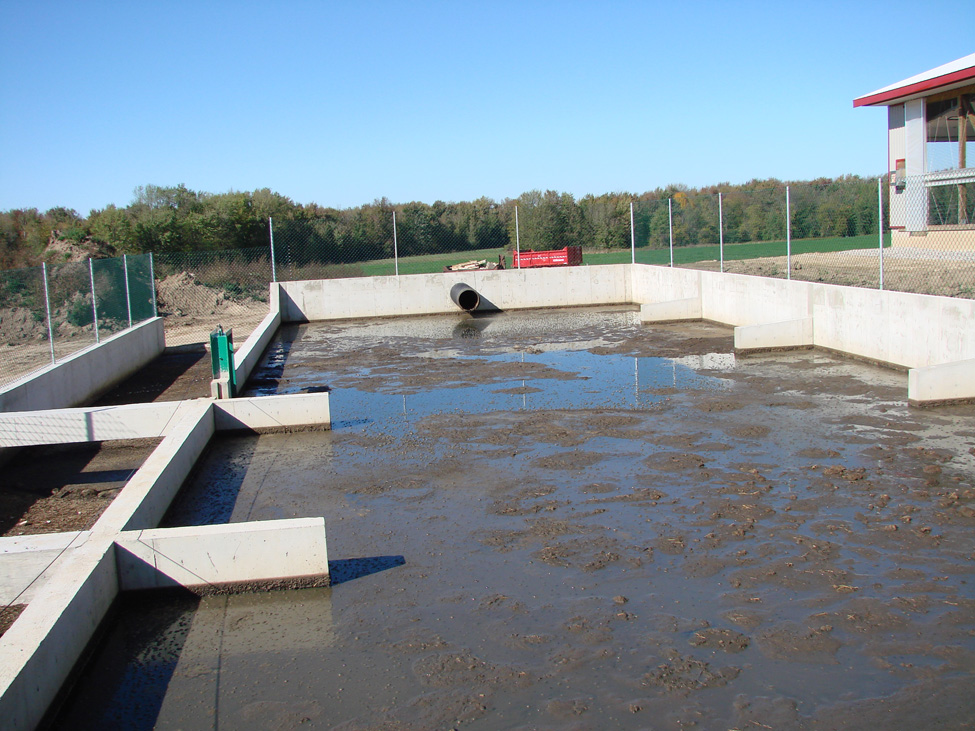
Flush/settling lanes
A further improvement on settling tanks or basins are sand-settling lanes. These are long, wide lanes with very little slope where the sand-laden manure is flushed into one end, and the liquid leaving the opposite end is directed into the long-term storage (Figure 12).
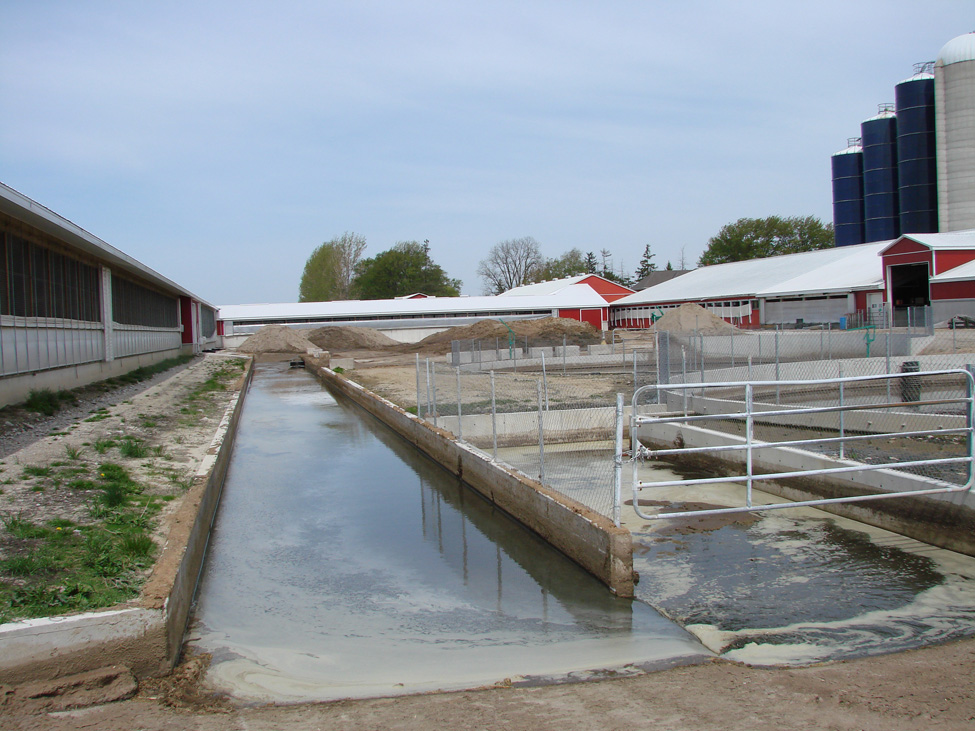
With a proper design, the coarse sand particles settle out next to the flush entrance with finer particles settling out along the length of the lane. The liquid and manure are left to flow into the long-term storage. The lane is designed with a ramp to allow the sand to be retrieved from the settling lane and piled beside the lane for drainage. When this system is working properly, the sand retrieved from the settling lane is clean enough to be re-used in the stalls. The recommended specifications for sand-settling lanes are:
- 3–4.6 m (10–15 ft) wide (width based on inlet water volume)
- 38–91 m (125–300 ft) long
- 0.1%–0.25% slope
Some sand-settling lanes run 30 m (100 ft) in one direction and then turn 180˚ and run in the opposite direction to save space.
Freezing conditions cause problems with settling basins and lanes. When the sand-laden manure starts to freeze, it will not settle properly. As a rule, the system will not completely freeze up, and liquid still finds a way through to the long-term storage, but the sand retrieved from the settling tank is not clean enough to re-use and will have to be field applied.
Mechanical separation
The most positive way to remove the sand from the sand-laden manure is to use a mechanical sand separator. There are only a couple on the market at present that are designed specifically to work with sand (Figure 13). The mechanical separators require dilution water to be added to the sand-laden manure. Air or extra water is added to the sand-laden manure to encourage separation. Attachments are available to further clean the sand.

With this system, the sand is re-used in the stalls. Over time, the fine sand particles are completely removed from the system, and the recycled sand becomes uniform in size and weight. The fineness or coarseness of the sand that is separated for recycling through the stalls is determined by how the machine is adjusted.
These machines are built with heavy-duty components to avoid wear and tear. They require extra water for dilution, and a number of pumps to provide a uniform supply of sand-laden manure to the separator and to transfer the liquid manure to long-term storage.
Other mechanical separators not designed specifically for separating sand can be used for partial sand separation and then used in conjunction with a sand-settling lane to achieve a reusable product.
Long-term storage
Sand-laden manure can be stored in any storage designed for liquid manure. Some producers have tried mixing straw bedding with sand-laden manure so that it will stack. This requires extra labour and extra bedding, and the result has not been positive. The sand-laden manure/straw mixture may stack to a height of 1.2–1.5 m (4–5 ft) but becomes very fluid again if the storage is not covered. In the end, it is best to treat sand-laden manure as liquid manure. As such, sand-laden manure can be stored in either an earthen storage or a circular open-top concrete storage.
Since a certain amount of sand will settle out during agitation and pumping, there must be a means of cleaning out the sediment in the tank. Earthen storages can be equipped with a ramp that allows a tractor and loader or skid steer into the earthen storage. Some circular concrete storages have been built with a ramp into the storage. This ramp is too steep to allow entry of a manure spreader and tractor but allows a tractor and loader or skid steer into the tank. Ramps are a very expensive addition to the manure storage as the reinforcing steel is no longer continuous around the tank. To contend with the concentrated forces at the ramp location, extra reinforcing steel is normally added in this area and tied into a beam over the top of the ramp. Even then, some cracking and wall failure have resulted. Because of the extra expense and structural issues, ramps are not often used in these liquid storages.
Removal from storage and land application
Removing sand-laden manure from the long-term storage presents many challenges. Most producers agitate the storage, pump off as much sand-laden manure using conventional liquid manure-handling equipment as possible, then use a high hoe to remove the remaining sediment.
The finer the sand used as bedding, the more it will stay in suspension with the manure, and more is removed by agitating and pumping. Agitation of the sand-laden manure becomes as much of an art, as a science. It is best to agitate the storage from at least two locations, if not more. The trick is to agitate enough to mix the sand and manure so that the tank is emptied with a pump, without mixing so much that the sand starts to settle out and produce “sand bars” in the storage.
Once the tank is agitated, liquid manure pumps and manure tankers are used to empty as much of the storage as possible. Drag lines can be used, but the abrasiveness of the sand increases the wear and tear on all the pumps and equipment. Once all the liquid sand-laden manure is removed from the storage, there is a more solid, sand-laden sediment left in the bottom of the storage. There may not be enough volume to clean out every time the tank is agitated and pumped, but eventually the sediment has to be cleaned out. This is best done with a high hoe with at least two access points into the tank. The high hoe is used to scoop the sand-laden manure sediment into “V-box” side discharge manure spreaders, or other special manure spreaders designed to handle sand-laden manure. Some applicators use dump wagons with the tail gate chained so it will only allow a small, even flow of sand-laden manure out the back.
Once the high hoe can no longer reach any further, a small skid steer is boomed into the tank using the high hoe. The skid steer is used to push the sand-laden manure up to the high hoe (Figure 14). If the storage has a ramp, the skid steer is driven into the manure storage. This method is used to remove all the sediment from the tank and may only be needed once every year or two.
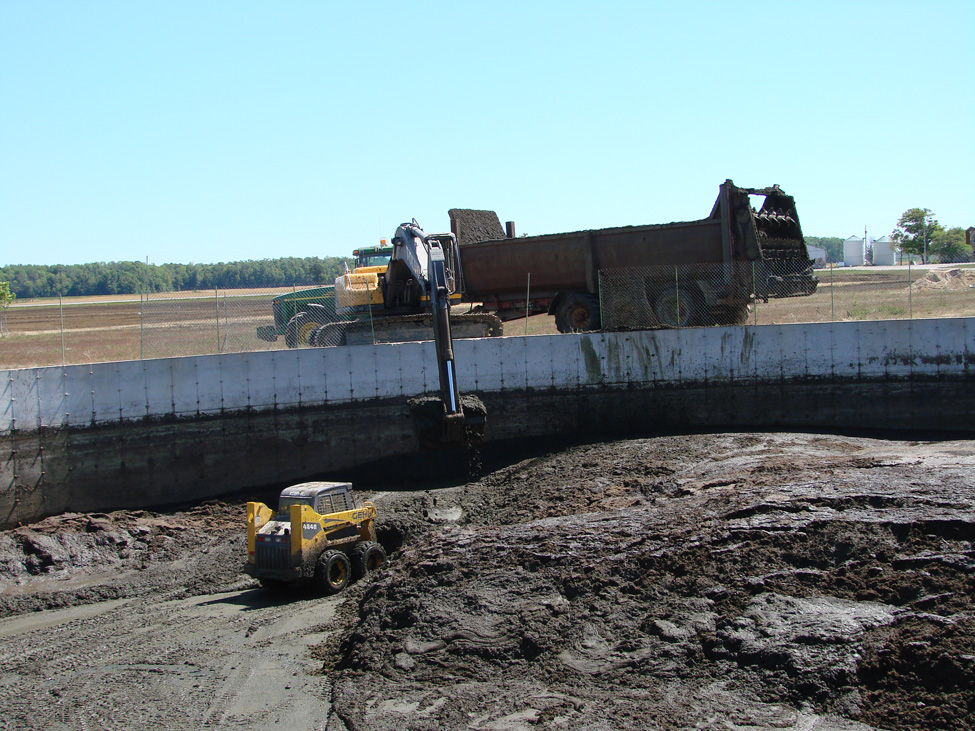
Calculating the nutrient content of the sand-laden manure spread on the field is another challenge. If both the liquid and solid portion are spread on the same field, it is not too difficult to determine the amount of nutrients going on that field. But often the liquid portion is spread on one field, and the solid portion is spread on another. If this is the case, collect nutrient samples for laboratory analysis of both the liquid portion and the solid portion. Adjust the application rates according to the individual nutrient contents of each material. Collecting representative samples of this material is difficult, and there is a lot of variability in nutrient content.
Anaerobic digestion and sand-laden manure
Many dairy producers are interested in developing biogas production from manure and wonder if biogas production is possible from sand-laden manure. At present it is not directly possible, due to sand settling in the digester and reducing its capacity over time. There are several anaerobic digesters working on dairy farms where sand is used as bedding, but the sand is first separated from the manure before it enters the digester. A continuously agitated digester would provide ideal conditions for sand separation within the digester, but at present this design has not been tried.
The other consideration is that separated solids from anaerobic digesters can be used as bedding. A number of producers have chosen this option and are quite happy with the results. In these systems, the stalls are designed similar to sand stalls with a curb at the back, but the digested solids are used instead of sand for bedding.
Summary
Sand provides an excellent bedding material for dairy cattle. It provides comfort, superior traction, reduces injuries and does not support bacterial growth. It is a low-cost material and readily available through most parts of the province.
Sand does increase wear and tear on manure-handling equipment. This is managed through careful selection of appropriate equipment. It takes extra time to fill and manage stalls, and emptying manure storages costs more than with other bedding systems. However, in spite of these drawbacks, dairy producers using sand are so happy with the benefits that it provides their cows, that they are willing to put up with the challenges.
This fact sheet was written by Harold K. House, P.Eng., dairy and beef housing and equipment engineer, OMAFRA and reviewed by Dr. Neil Anderson, D.V.M., lead veterinarian, disease prevention ruminant, OMAFRA, Jacqui Empson-Laporte, environmental specialist, OMAFRA and Daniel Ward, P.Eng., poultry and other livestock, housing and equipment engineer, OMAFRA.